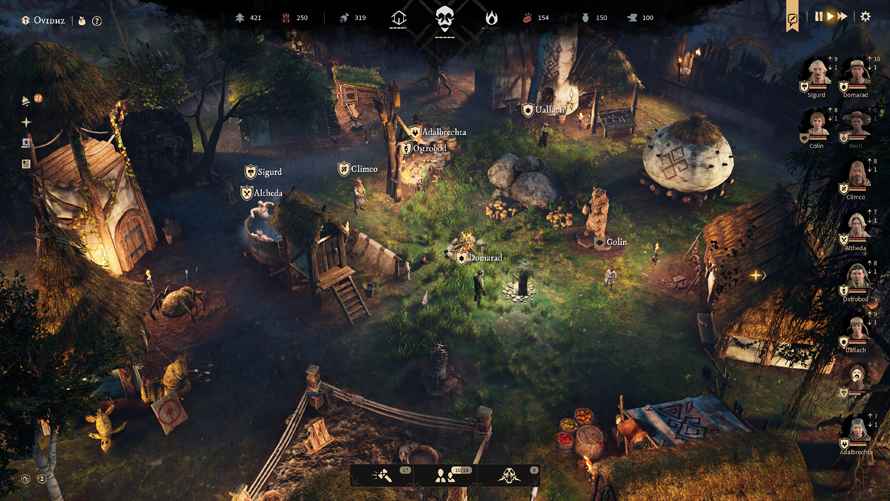Gord review
Don’t try to tell me that video games are not educational. For example, from playing Gord I learned that a gord is a Slavic medieval settlement, a small cluster of buildings surrounded by a wall. The game also taught me that, as the British say, I would be rubbish at surviving the terrors of a monster-filled medieval night.
Pedigreed Storytelling
Gord is a survival RTS game from developer Covenant.dev. Part of the team are veterans of CDProjekt Red and the Witcher franchise. This pedigree comes thoroughly through in Gord’s detailed and dark fantasy world. Literally dark, as in most of the action takes place at night, where the darkness hides all manner of danger.
The game’s narrative is brilliantly simple to start. You play as Bogdahn, wise elder of the Tribe of the Dawn. The King wants to expand his wealth and territory, but unfortunately the adjacent lands are corrupted by all manner of monsters and mercenaries. You want something, too, a new land for tribe. The King sends you forth into the dark wilderness, accompanied by an unwilling, loutish toady named Edwyn to keep tabs on you. The story is told through static illustrations and especially engaging animated cutscenes. Overall, the script and voice work are good.

As the tribe ventures deeper and deeper into the woods, the cast of characters grows. Some you can control as part of your party. Others. like a witch you encounter early on, are more autonomous. While she isn’t controllable, she gives your people access to powerful spells and incantations.
Insane Gameplay
Not unlike Rimworld and other strategy/RPGs, the psychological states of your people matter as much as their physical health. Expose them to too much trauma like decaying corpses, venturing into the woods alone or some of the more terrifying bosses, and they will go insane. Insanity is curable, given the right shrine or magic but a better strategy becomes exploring in groups. Likewise, physical injuries can be healed by visiting specialized huts, but permanent death is a real possibility.
While members of your small tribe each have specific roles — like scout or forager — those roles can be reassigned as needed. Generally, there isn’t a lot of micromanagement. You don’t have to worry about things like hunger, thirst or sleep, and once you assign a task, your party member continues unprompted. Your group always remains small, because Gord isn’t about creating massive fortresses or large forces. Your humble woodcutter will need to train up to fight.

Into the Weeds
Gord’s campaign is divided into bite-size chunks with manageable main goals and occasional sub-quests. Each main chapter is capped with some sort of boss encounter. What is interesting is that combat is not necessarily the only viable option, especially early in the game. For example, some bosses can be placated with a human sacrifice. Maybe even a child sacrifice. Luckily — well, maybe that’s a poor choice of words — the game drops a youngster into your group not long before. It’s a horrific choice, of course, and Gord doesn’t shy away from grimdark, fairy-tale moral dilemmas.
In addition to the seven or so bosses, most of which come from Slavic folk tales, there are hosts of other enemies. Although the woods are full of helpful items to harvest, they’re also thick with things that can kill you. Wild animals, monsters and roving packs of wild humans turned savage are just a few of Gord’s dangers. You can adjust the difficulty. The easiest setting is maybe too forgiving. But if you want more of a chill-and-build experience, it’s a good option.
Hammers and Nails
The building and RTS components of Gord are pretty standard fare. You gather resources and build specialized huts for crafting, housing, comfort, healing, magic and defense. It sounds like a lot, but in practice, your group remains small and the gord is compact. Although combat is real-time, you can hit pause and make some tactical choices if needed.
The interface has a lot going on, and at least on console, managing it was frustrating. Controls seemed a bit laggy or imprecise, and nearly every command necessitated at least two menus or inputs. There are radial menus nested in other radial menus and all sort of information that clutters the screen without being easily accessed. It made me desperately wish I was playing with mouse and keyboard. A bit of frustration — at least using a controller — extends to the camera and its inability to move easily and precisely.

A lot of Gord’s appeal comes from its visual design and excellent character animations. The woods are dark and mysterious, with a claustrophobic fog-of-war shrouding everything around your gord. Excellent weather, lighting and other effects add to the impressive visuals, and the static art is thoroughly drenched in dark fairy tale style. However, there were more than a few times when there was simply too much texture or environmental decoration to see and move clearly.
Here There Be Monsters
Gord is a richer and more complex game than it first appears. There are interesting layers of moral ambiguity and mental health to consider. Gord is a dark Slavic folk tale in survival/RTS-game disguise. Its mechanics and systems add up to an engaging gameplay experience. For a modest entry price, Gord provides a lot of entertainment, an engaging story and plenty of replay value via customizable scenarios.
***PS5 code provided by the publisher for review***
The Good
- Great atmosphere
- Engaging, challenging gameplay
- Interesting setting and story
The Bad
- Visually fatiguing in parts
- Frustrating controller implementation

